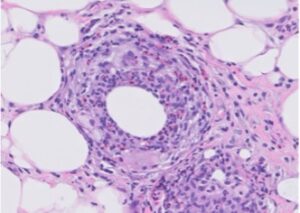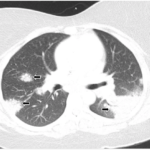Compared with the CT scan of the patient’s abdomen from 2007, the current CT scan revealed ill-defined infiltration of the omentum and mesentery. Diagnostic laparoscopy, lysis of adhesions, omental and small bowel biopsy were performed.
Pathology revealed donut-shaped, non-necrotizing epithelioid granulomas with punched-out central spaces and rare, silver birefringent crystals, atypical for sarcoidosis and more suggestive of a foreign body reaction (see Figures 1A & 1B). The patient was also incidentally found to have elevated liver enzymes. Hepatitis serologies and anti-smooth muscle antibodies were negative. Because his liver enzymes continued to rise, a liver biopsy was performed, and the results were consistent with a nonspecific reactive hepatitis possibly due to a drug reaction unrelated to his granulomatous disease.
Based on these findings, the patient was started on high-dose glucocorticoids and mycophenolate mofetil. His fevers resolved, and the severity of his abdominal pain decreased. He was followed in the clinic, with continued improvement of his symptoms.
Discussion
Asbestos, among other toxic irritants, was found in the dust and air after the WTC collapse. A study of 5,000 Ground Zero rescue workers demonstrated they had an average lung impairment of 10%, based on pulmonary function tests.1 Many individuals who were exposed to the site still experience myriad symptoms, most of which are pulmonary and gastrointestinal.2
Our patient was diagnosed with sarcoidosis in 2008, thought to be related to exposure to the WTC dust at Ground Zero. He continued to develop worsening abdominal pain and constitutional symptoms. However, he did not exhibit any other typical symptoms consistent with sarcoidosis.3 Further, the histopathology of his peritoneum was atypical for sarcoidosis and lacked fibrin rings, which are characteristic of Coxiella burnetii infection. The differentials for granulomatous disease include infectious causes (e.g., tuberculosis) and non-infectious causes (e.g., sarcoidosis, inflammatory bowel disease, hypersensitivity pneumonitis, granulomatosis with polyangiitis).
Vascular-associated granulomas rich in eosinophils can be seen in certain types of hypersensitivity reactions, and the presence of silver birefringent crystals and punched-out granulomas were suggestive of a foreign body. Lastly, although hypersensitivity reactions are heterogenous and may not always respond to glucocorticoids, the resolution of this patient’s symptoms after corticosteroid initiation can be consistent with an inflammatory reaction.
Overall, this case highlights potential issues surrounding individuals who are suffering long-term effects from exposure to the dust at Ground Zero. The patient stated that in the intervening years, he has learned of about 60 of his colleagues from the WTC site who were also diagnosed with sarcoidosis, although we were unable to independently verify this number.



